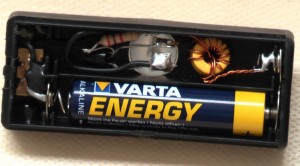Harri sent me some pictures of his LED flashlight or torch projects. One uses a circuit similar to my Supercharged Joule Thief but without the resistor. The other is a two transistor circuit. With his permission I’ll quote his descriptions of the pictures.
Pic1: This is like your SJT, only diode ditched and resistor value decreased to get maximum brightness. This circuit takes about 200 mA from a fresh battery and brightness is awesome. Conventional JT’s that I’ve made with 3k9 resistor takes about 40mA from fresh battery.
Pic2: This one is without a handwound toroid and has 2 transistors. Works well.
Parts that I have used:
LED: 4-chip 80mA warm white diffused 10mm led from LED1.de.
Boxes: from dealextreme.com (around 1,5 $ a piece). SKU103845
for 2 AA-battery, SKU103862 for 2 AAA-battery. (Second battery contact removed and JT fitted in.)
Resistor for conventional JT: 2k7 or 3k9.
Toroids I use vary a lot, usually recycled from the dead energy saving lightbulbs. Some seems to work better than the others.
Pics 3, 4 and 5 shows complete units.
I haven’t tried replacing the diode with a short in my SJT. Without the extra DC bias caused by the diode, I would guess that there would be much less voltage across the capacitor and much less current through the transistor and the LED would be much dimmer using the same resistor (I used 1.5k in my SJT). That’s apparently why his adjustable resistor gave the best brightness when set to 560 ohms. My next thought is will the capacitor cause the same effect as in my SJT? It increases the frequency and the efficiency a large amount.
Harri sent me another two closeups, one of which I’ll show here, since it shows the parts and how they’re connected. This makes it easy for the experimenter to use the same kind of case and get it up and running.